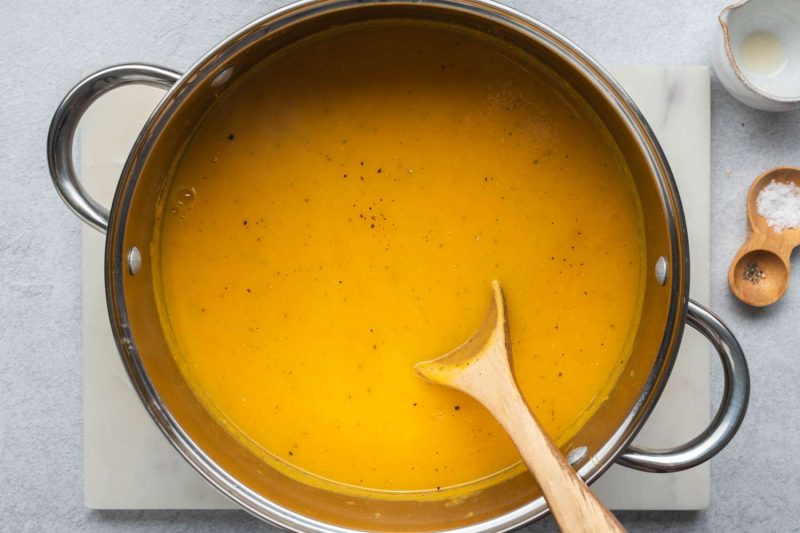One of the most basic kitchen skills one should master, right up there with seasoning and chopping, is thickening a soup. When you're after something heartier and creamier but not quite a stew, there are many alternatives to achieve the perfect thickness.
Even if reducing the soup could help, you might cause some of the ingredients to overcook. We’ve rounded up the best hacks for thickening a soup. It’s as easy as using the soup itself, using starchy ingredients—beans, potatoes, rice, flour, or cornstarch—or adding dairy. There’s no reason to sit down to a bowl of watery soup if you use one of our recommended methods.
Using the Soup Itself
Perhaps the easiest way to thicken a soup is to puree it. Or, put another way, pureed soups are the easiest soups to thicken. This is because the pureeing itself is often all you need to achieve your desired consistency.
Pureeing only some of the soup can work wonders. Ladle out a portion of the soup, puree it in a blender or in a separate container using an immersion blender, and then stir the pureed portion back into the pot. This method will work with just about any soup and requires no additional ingredients or thickeners.
Using Potatoes, Rice, Pasta, or Beans
If your pureed soup is still too thin, thickening it further is simply a matter of adding a neutral starch:
- Use cooked potatoes, rice, stale bread, mashed potatoes, or frozen hash browns. Just simmer briefly to release the starches and then puree. Don’t overdo it, though. Starches absorb liquid as they’re heated, so your soup can easily become too thick if you add too much starch, especially if it has time to stand. Start with a little, puree it, return it to the pot and warm it back up. Then check for seasonings and texture. Russet potatoes are best for this approach, as they don’t hold their firmness for long.
- Use potatoes but don’t puree the soup. Cut the raw potatoes in chunks and allow their natural starches to be released into the cooking liquid. The soup will have more body and creaminess. This technique will work its magic in as few as 20 minutes of simmering, at which time you should be able to easily pierce the potato chunks with a fork. White, red, and Yukon Gold potatoes are best for this method.
- Use yams and sweet potatoes the same way you’d use regular potatoes, or other starchy vegetables like carrots, beets, pumpkin, parsnips, peas, beans, or corn. Celery root, peeled, diced, and simmered, will add a wonderful mild flavor and aroma of celery to your soup.
- Use rice, pasta, beans, or grains like oats and barley to naturally add thickness. The starches in a handful of uncooked rice will permeate the cooking liquid as it simmers. When the rice is soft, your soup is done. This method works better than adding cooked rice, although that will work in a pinch, especially if you’re pureeing. Starchy rice like Arborio—the kind used for making risotto—are especially powerful thickeners. Uncooked grains like oats and barley will also work the same way, and so will dried pasta and quick-cooking legumes like lentils. Just simmer the soup until they’re soft.
Using Flour, Cornstarch, or Arrowroot
Sometimes ingredients alone are not enough to thicken your soup adequately. In that case, flour, cornstarch, or some other thickening agent like arrowroot can work best, especially if you don't have a pureeing tool:
- Use flour by cooking it with butter or oil to make a roux. This works best at the beginning of cooking since you prepare the roux at the bottom of the pot, then build the soup from there. Because many soup recipes start with sautéing onions and other aromatics in oil or fat, you can simply sprinkle the flour into the cooked aromatics and their fat and stir to form a paste. Then whisk in your hot broth or stock.
- Use beurre manie—a putty of equal parts by weight of softened butter and flour that you knead together and then stir, bit by bit, into your soup. The fat helps join the starch to the liquid so that you don’t just end up with clumps of flour in your soup. This technique, or adding a roux made in a separate pan, works best for soups that are already cooked that need a thickener. Make a roux or a beurre manie using non-wheat flours like rice flour, as well as your favorite gluten-free flour blends.
- Use cornstarch, another powerful thickener. Combine a small amount of cornstarch with cold water in a bowl and mix until blended. Slowly and carefully whisk the slurry into the soup. If you add the slurry directly into the hot liquid, it will clump and might not disperse. Use arrowroot and tapioca starch like you’d use cornstarch, but keep in mind that cornstarch is less effective in tomato-based soups, while arrowroot can impart an unpleasant texture to dairy-based soups.
Using Dairy
The addition of a small amount of full-fat cream, sour cream, or yogurt is often enough to thicken a soup without necessarily turning it into a dairy-based soup:
- Watch out for curdling, which happens when the heat of the soup or acid in the soup causes the milk proteins or whey to separate from the water and fat. In general, the higher the fat, the better the dairy product will combine with a hot soup without curdling. Thus, heavy cream will work better than half-and-half or milk.


